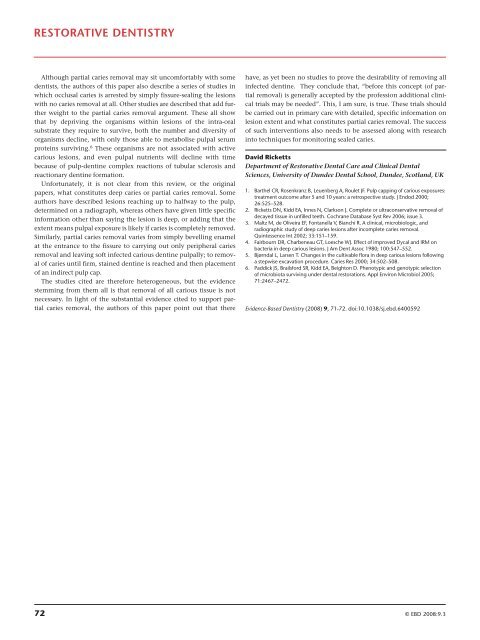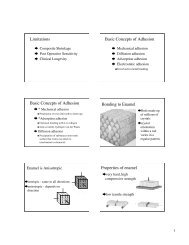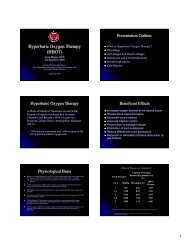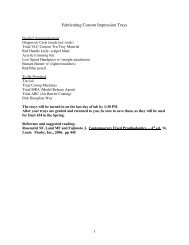Management of the deep carious lesion and the - Ohio State ...
Management of the deep carious lesion and the - Ohio State ...
Management of the deep carious lesion and the - Ohio State ...
Create successful ePaper yourself
Turn your PDF publications into a flip-book with our unique Google optimized e-Paper software.
RESTORATIVE DENTISTRY<br />
Although partial caries removal may sit uncomfortably with some<br />
dentists, <strong>the</strong> authors <strong>of</strong> this paper also describe a series <strong>of</strong> studies in<br />
which occlusal caries is arrested by simply fissure-sealing <strong>the</strong> <strong>lesion</strong>s<br />
with no caries removal at all. O<strong>the</strong>r studies are described that add fur<strong>the</strong>r<br />
weight to <strong>the</strong> partial caries removal argument. These all show<br />
that by depriving <strong>the</strong> organisms within <strong>lesion</strong>s <strong>of</strong> <strong>the</strong> intra-oral<br />
substrate <strong>the</strong>y require to survive, both <strong>the</strong> number <strong>and</strong> diversity <strong>of</strong><br />
organisms decline, with only those able to metabolise pulpal serum<br />
proteins surviving. 6 These organisms are not associated with active<br />
<strong>carious</strong> <strong>lesion</strong>s, <strong>and</strong> even pulpal nutrients will decline with time<br />
because <strong>of</strong> pulp-dentine complex reactions <strong>of</strong> tubular sclerosis <strong>and</strong><br />
reactionary dentine formation.<br />
Unfortunately, it is not clear from this review, or <strong>the</strong> original<br />
papers, what constitutes <strong>deep</strong> caries or partial caries removal. Some<br />
authors have described <strong>lesion</strong>s reaching up to halfway to <strong>the</strong> pulp,<br />
determined on a radiograph, whereas o<strong>the</strong>rs have given little specific<br />
information o<strong>the</strong>r than saying <strong>the</strong> <strong>lesion</strong> is <strong>deep</strong>, or adding that <strong>the</strong><br />
extent means pulpal exposure is likely if caries is completely removed.<br />
Similarly, partial caries removal varies from simply bevelling enamel<br />
at <strong>the</strong> entrance to <strong>the</strong> fissure to carrying out only peripheral caries<br />
removal <strong>and</strong> leaving s<strong>of</strong>t infected <strong>carious</strong> dentine pulpally; to removal<br />
<strong>of</strong> caries until firm, stained dentine is reached <strong>and</strong> <strong>the</strong>n placement<br />
<strong>of</strong> an indirect pulp cap.<br />
The studies cited are <strong>the</strong>refore heterogeneous, but <strong>the</strong> evidence<br />
stemming from <strong>the</strong>m all is that removal <strong>of</strong> all <strong>carious</strong> tissue is not<br />
necessary. In light <strong>of</strong> <strong>the</strong> substantial evidence cited to support partial<br />
caries removal, <strong>the</strong> authors <strong>of</strong> this paper point out that <strong>the</strong>re<br />
have, as yet been no studies to prove <strong>the</strong> desirability <strong>of</strong> removing all<br />
infected dentine. They conclude that, “before this concept (<strong>of</strong> partial<br />
removal) is generally accepted by <strong>the</strong> pr<strong>of</strong>ession additional clinical<br />
trials may be needed”. This, I am sure, is true. These trials should<br />
be carried out in primary care with detailed, specific information on<br />
<strong>lesion</strong> extent <strong>and</strong> what constitutes partial caries removal. The success<br />
<strong>of</strong> such interventions also needs to be assessed along with research<br />
into techniques for monitoring sealed caries.<br />
David Ricketts<br />
Department <strong>of</strong> Restorative Dental Care <strong>and</strong> Clinical Dental<br />
Sciences, University <strong>of</strong> Dundee Dental School, Dundee, Scotl<strong>and</strong>, UK<br />
1. Bar<strong>the</strong>l CR, Rosenkranz B, Leuenberg A, Roulet JF. Pulp capping <strong>of</strong> <strong>carious</strong> exposures:<br />
treatment outcome after 5 <strong>and</strong> 10 years: a retrospective study. J Endod 2000;<br />
26:525–528.<br />
2. Ricketts DN, Kidd EA, Innes N, Clarkson J. Complete or ultraconservative removal <strong>of</strong><br />
decayed tissue in unfilled teeth. Cochrane Database Syst Rev 2006; issue 3.<br />
3. Maltz M, de Oliveira EF, Fontanella V, Bianchi R. A clinical, microbiologic, <strong>and</strong><br />
radiographic study <strong>of</strong> <strong>deep</strong> caries <strong>lesion</strong>s after incomplete caries removal.<br />
Quintessence Int 2002; 33:151–159.<br />
4. Fairbourn DR, Charbeneau GT, Loesche WJ. Effect <strong>of</strong> improved Dycal <strong>and</strong> IRM on<br />
bacteria in <strong>deep</strong> <strong>carious</strong> <strong>lesion</strong>s. J Am Dent Assoc 1980; 100:547–552.<br />
5. Bjørndal L, Larsen T. Changes in <strong>the</strong> cultivable flora in <strong>deep</strong> <strong>carious</strong> <strong>lesion</strong>s following<br />
a stepwise excavation procedure. Caries Res 2000; 34:502–508.<br />
6. Paddick JS, Brailsford SR, Kidd EA, Beighton D. Phenotypic <strong>and</strong> genotypic selection<br />
<strong>of</strong> microbiota surviving under dental restorations. Appl Environ Microbiol 2005;<br />
71:2467–2472.<br />
Evidence-Based Dentistry (2008) 9, 71-72. doi:10.1038/sj.ebd.6400592<br />
72 © EBD 2008:9.3






